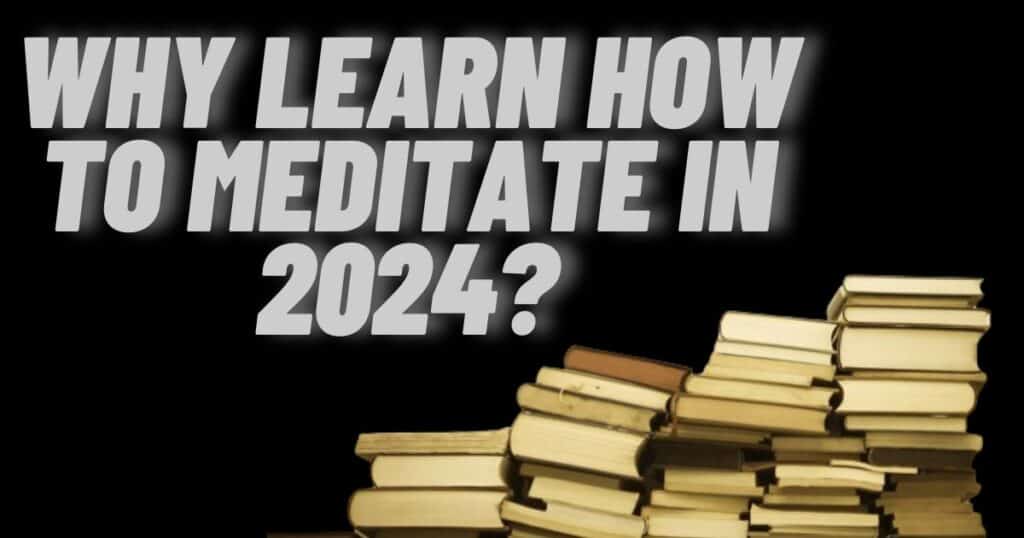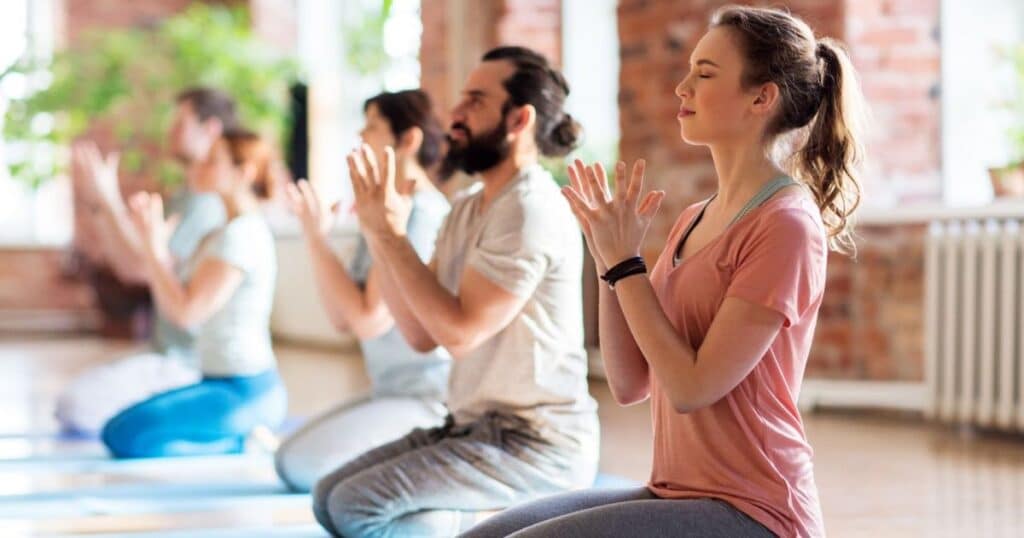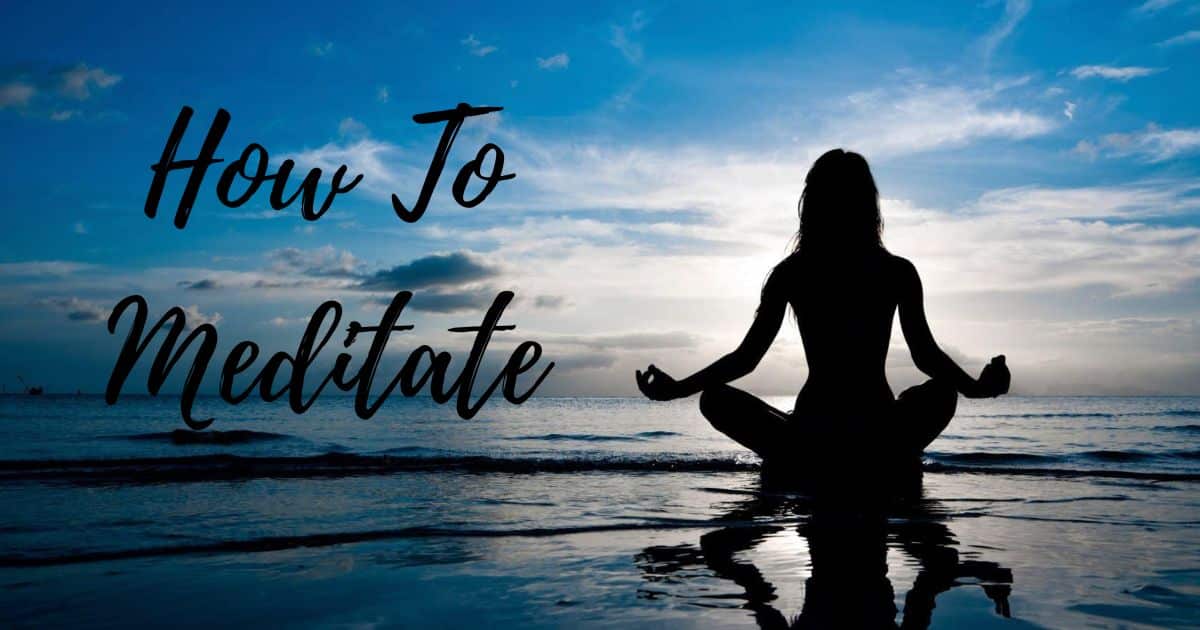When we meditate, we inject far-reaching and long-lasting benefits into our lives: We lower our stress levels, we get to know our pain, we connect better, we improve our focus, and we’re kinder to ourselves. Let us walk you through the basics in our new mindful guide on how to meditate.
What is Meditation?
Meditation is an ancient practice that trains the mind to achieve a state of profound calm and heightened awareness. It involves focusing one’s attention on a particular object, thought, or activity to still the constant chatter of the mind and experience the present moment with clarity and acceptance.
Why Learn How to Meditate in 2024?

In our fast-paced, technology-driven world, the benefits of meditation have become increasingly relevant. Here are five compelling reasons to embrace mindfulness in 2024:
- Stress Relief: Meditation has been scientifically proven to reduce stress levels, lower blood pressure, and promote a sense of tranquility amidst life’s chaos.
- Improved Focus and Productivity: By training your mind to stay present, meditation enhances your ability to concentrate, multitask, and approach tasks with renewed energy and efficiency.
- Emotional Resilience: Regular meditation practice cultivates emotional intelligence, helping you navigate challenges with greater equanimity and resilience.
- Enhanced Creativity: Quieting the constant mental chatter allows space for innovative ideas and creative solutions to emerge.
- Better Sleep: Meditation has been shown to improve sleep quality, allowing you to wake up refreshed and ready to tackle the day.
How to Meditate?
Meditation is a skill that can be learned and mastered with practice. Here’s a simple guide to get you started:
How Much Should I Meditate?
While there’s no one-size-fits-all answer, most experts recommend starting with 10-15 minutes per day and gradually increasing the duration as you become more comfortable with the practice.
Meditation Tips and Techniques
- Find a comfortable position: Sit upright on a cushion or chair, with your spine straight but relaxed.
- Focus on your breath: Breathe naturally, and bring your attention to the sensations of inhaling and exhaling.
- Notice distractions: When your mind wanders, gently acknowledge the distraction and return your focus to your breath.
- Be kind to yourself: Meditation takes practice, so approach it with patience and compassion.
How to Make Mindfulness a Habit
Consistency is key to reaping the full benefits of meditation. Consider setting a daily reminder, joining a local meditation group, or signing up for our newsletter to receive regular mindfulness tips and inspiration.
Some Basic Meditations
These are some meditation practices to get you going.
A Basic Meditation for Beginners
Start by finding a quiet, comfortable spot. Sit upright with your eyes closed or gaze softly downward. Bring your attention to your breath, noticing the natural flow of inhalations and exhalations. When your mind wanders, gently redirect your focus back to your breath.
3 Guided Meditations for Beginners
- Body Scan Meditation: This practice involves systematically focusing your attention on different parts of your body, cultivating awareness and relaxation.
- Loving-Kindness Meditation: Also known as “metta,” this meditation promotes feelings of warmth, compassion, and goodwill towards yourself and others.
- Nature Meditation: Connect with the natural world by meditating outdoors, allowing the sights, sounds, and smells of nature to anchor you in the present moment.
1-Minute Meditation
Even a minute of mindfulness can make a difference. Close your eyes, take a deep breath, and bring your attention to the present moment, letting go of thoughts about the past or future.
10-Minute Meditation
Find a comfortable seated position and set a timer for 10 minutes. Begin by taking a few deep breaths, then follow your natural breath as you inhale and exhale. When your mind wanders, gently redirect your attention back to your breath.
15-Minute Meditation
Settle into a comfortable posture and set a timer for 15 minutes. Start by focusing on your breath, then gradually expand your awareness to the sensations in your body, the sounds around you, and the present moment as a whole. Embrace whatever arises with acceptance and curiosity.
More Styles of Mindfulness Meditation

Once you have explored a basic seated meditation practice, you might want to consider other forms of meditation including walking and lying down. Whereas the previous meditations used the breath as a focal point for practice, these meditations below focus on different parts of the body.
Introduction to the Body Scan Meditation
The body scan meditation is a powerful tool for cultivating present-moment awareness and releasing physical tension. In this practice, you systematically direct your attention to different areas of your body, observing any sensations that arise with a gentle, non-judgmental attitude.
Body Scan Meditation
- Find a comfortable lying or seated position.
- Begin by bringing your attention to your breath, taking a few deep breaths.
- Gradually shift your focus to the soles of your feet, noticing any sensations present.
- Slowly work your way up, scanning your legs, hips, abdomen, back, shoulders, arms, hands, and finally your head.
- If your mind wanders, gently redirect your attention to the area you’re currently focusing on.
- After completing the body scan, take a few moments to notice how you feel overall.
Introduction to the Walking Meditation
The walking meditation is a mindfulness practice that combines physical movement with present-moment awareness. By synchronizing your breath with your steps, you anchor yourself in the here and now, cultivating a sense of grounded presence.
Walking Meditation
- Find a quiet, open space where you can walk back and forth for a few minutes.
- Stand upright, with your eyes open and your gaze softly focused a few feet in front of you.
- Begin walking at a slow, comfortable pace, coordinating your steps with your breath.
- As you inhale, take a step with your right foot. As you exhale, take a step with your left foot.
- Maintain your awareness on the sensations of walking, the movement of your body, and the rhythm of your breath.
- If your mind wanders, gently bring your attention back to the present moment.
Also Read: How To Meditate? Complete Guide On Tips And Benefits
Introduction to Loving-Kindness Meditation
The loving-kindness meditation, also known as “metta,” is a practice that cultivates feelings of warmth, compassion, and goodwill towards yourself and others. This meditation can help dissolve negative emotions and foster a sense of interconnectedness with all beings.
A Loving-Kindness Meditation
- Find a comfortable seated position and take a few deep breaths.
- Bring to mind someone you deeply care about and feel genuine warmth towards.
- Silently repeat phrases of well-wishing, such as “May you be happy, may you be healthy, may you live with ease.”
- After a few minutes, extend these feelings of kindness towards yourself, using phrases like “May I be happy, may I be healthy, may I live with ease.”
- Gradually expand your circle of kindness to include friends, acquaintances, and eventually all beings everywhere.
- If your mind wanders, gently redirect your attention back to the phrases of well-wishing.
Remember, meditation is a journey, and the most important step is to simply begin. Embrace the practice with an open heart, and watch as it gradually transforms your life, one mindful moment at a time.
Integrating Meditation Into Your Daily Routine
Making meditation a consistent habit can be challenging, but it’s crucial for experiencing its full benefits. Here are some tips for seamlessly integrating mindfulness into your daily routine:
Set a Reminder
Use a calendar app or set a daily alarm on your phone to remind you to meditate at the same time each day. Consistency is key when establishing a new habit.
Create a Dedicated Space
Designate a quiet, comfortable area in your home specifically for meditation. This could be a corner of your bedroom, a cozy armchair, or even a spot in your backyard. Creating a dedicated space can help signal to your brain that it’s time to practice mindfulness.
Try Guided Meditations
If you’re struggling to meditate on your own, consider using guided meditations. There are numerous apps, podcasts, and YouTube videos that offer structured meditations led by experienced teachers.
Meditate on the Go
Meditation doesn’t have to be limited to a specific location. You can practice mindfulness while commuting, waiting in line, or even during your lunch break. Simply focus on your breath or the sensations of your body for a few minutes to cultivate present-moment awareness.
Overcoming Common Meditation Obstacles

Even the most dedicated practitioners can encounter obstacles when it comes to maintaining a consistent meditation practice. Here are some common challenges and strategies for overcoming them:
Restlessness or Boredom
If you find yourself fidgeting or feeling bored during meditation, try switching to a more active form of mindfulness, such as a walking meditation or a body scan. You can also experiment with different meditation styles or guided practices to keep your mind engaged.
Intrusive Thoughts
It’s natural for thoughts to arise during meditation, but it’s important not to get caught up in them. When you notice your mind wandering, gently acknowledge the thought and redirect your attention back to your breath or chosen anchor.
Lack of Motivation
Motivation can ebb and flow, even for seasoned meditators. When you’re feeling unmotivated, remind yourself of the benefits you’ve experienced from meditation and the reasons you started practicing in the first place. You can also try setting a small, achievable goal, like meditating for just five minutes each day.
Physical Discomfort
If you’re experiencing physical discomfort during meditation, such as back pain or numbness in your legs, don’t hesitate to adjust your posture or take a break. Meditation should be a comfortable experience, not a struggle against pain.
Remember, overcoming obstacles is part of the journey. Approach each challenge with compassion and patience, and trust that your meditation practice will ultimately deepen and flourish.
The Science Behind Meditation
While meditation has been practiced for centuries, modern science has shed light on the profound effects it can have on the brain and overall well-being. Here’s a glimpse into the neuroscience of meditation:
Structural Brain Changes
Research has shown that regular meditation can actually change the structure of the brain. Specifically, it can increase the density of gray matter in regions associated with learning, memory, emotional regulation, and self-awareness.
Improved Emotional Intelligence
Meditation has been found to enhance activity in the prefrontal cortex, the area of the brain responsible for emotional regulation and decision-making. This can lead to improved emotional intelligence, greater empathy, and better management of stress and negative emotions.
Reduced Anxiety and Depression
Numerous studies have demonstrated the effectiveness of meditation in reducing symptoms of anxiety and depression. By promoting relaxation and cognitive flexibility, meditation can help break the cycle of negative thought patterns and emotional distress.
Boosted Immune Function
Surprisingly, meditation has been linked to improved immune function. Research suggests that regular practice can decrease inflammation and boost the activity of cells responsible for fighting off viruses and illnesses.
Increased Focus and Attention
Meditation has been shown to enhance activity in the brain’s attention networks, leading to improved focus, concentration, and cognitive performance. This can have significant implications for productivity, decision-making, and overall mental clarity.
As scientific research continues to explore the intricate relationship between meditation and the brain, the benefits of this ancient practice become increasingly evident and compelling.
Meditation And Personal Growth

Beyond its physical and mental health benefits, meditation can be a powerful catalyst for personal growth and self-discovery. Here’s how mindfulness can support your journey of self-exploration and transformation:
Cultivating Self-Awareness
By turning inward and observing your thoughts, emotions, and physical sensations without judgment, meditation fosters a deeper understanding of yourself. This heightened self-awareness can help you identify patterns, beliefs, and behaviors that may be holding you back.
Developing Emotional Intelligence
Meditation trains you to observe your emotions with detachment, allowing you to respond to challenging situations with greater equanimity and emotional intelligence. This can lead to improved relationships, better decision-making, and a greater sense of inner peace.
Enhancing Creativity and Intuition
By quieting the constant chatter of the mind, meditation creates space for creative insights and intuitive wisdom to emerge. Many artists, writers, and innovators have credited their meditation practice with unlocking new levels of creativity and inspiration.
Cultivating Compassion and Empathy
Certain forms of meditation, such as loving-kindness and compassion practices, can help dissolve feelings of separation and foster a deeper sense of interconnectedness with others. This can lead to greater empathy, understanding, and a desire to alleviate suffering in the world.
Finding Purpose and Meaning
As you deepen your meditation practice, you may find yourself naturally exploring questions of purpose, meaning, and your place in the larger tapestry of life. This can lead to a greater sense of fulfillment, gratitude, and a desire to live in alignment with your values.
Ultimately, meditation is not just a tool for stress relief or relaxation; it’s a gateway to profound personal growth and transformation. Embrace the journey with an open heart and mind, and allow the practice to unfold its many layers of wisdom and insight.
Conclusion
Meditation is a transformative practice that extends far beyond stress relief. It serves as a catalyst for profound personal growth and self-discovery. By cultivating self-awareness, emotional intelligence, and compassion, meditation empowers you to break free from limiting patterns and beliefs.
It unlocks creative potential, fosters a deeper sense of purpose, and helps you navigate life’s challenges with greater equanimity. As scientific research unveils the intricate benefits of meditation, embracing this ancient practice becomes increasingly compelling.
Approach your meditation journey with patience, open-mindedness, and a willingness to explore the depths of your inner world. The rewards of sustained practice are vast and life-changing.

George, an esteemed author with 8 years of experience in meditation, imparts transformative knowledge on meditatefulhub.com. His writings resonate globally, guiding individuals on a profound journey of self-discovery and inner peace.








![How to Cancel Your Brazzers Subscription Complete Guide [2024]](https://meditatefulhub.com/wp-content/uploads/2024/11/How-to-Cancel-Your-Brazzers-Subscription-Complete-Guide-2024-300x157.jpg)


